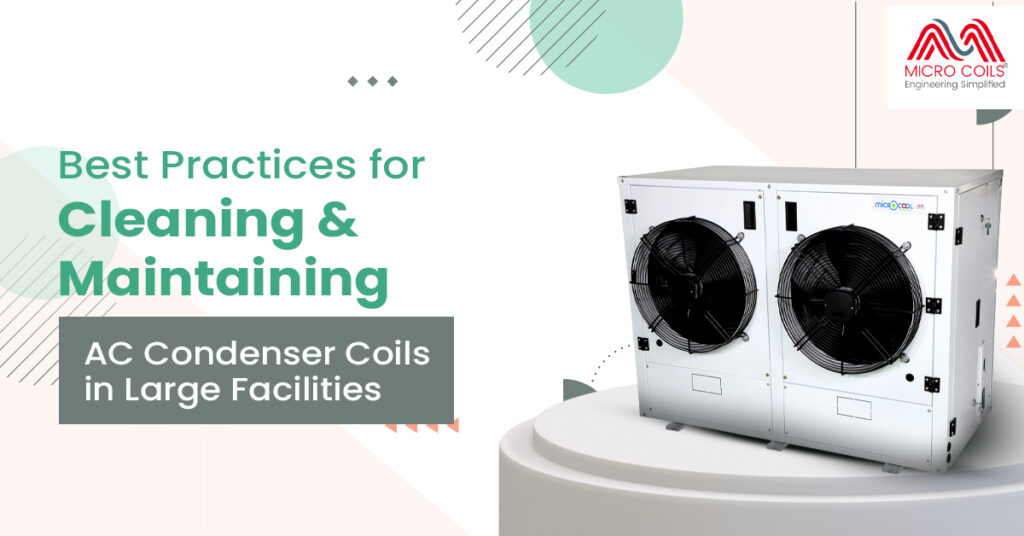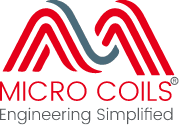
Large commercial and industrial facilities depend on efficient HVAC systems to maintain comfortable environments for employees and protect sensitive equipment. The ac condenser coil serves as a critical component in these systems, responsible for releasing heat from the refrigerant to the outdoor environment. Proper maintenance of these coils directly impacts system efficiency, energy costs, and equipment longevity. Many condenser coil manufacturers and heat exchanger manufacturers in India provide industrial-grade coil solutions tailored for such large facilities.
Neglected condenser coils can reduce system efficiency, leading to significantly higher energy bills and premature equipment failure. Understanding proper cleaning and maintenance procedures helps facility managers optimize performance while minimizing operational costs and unexpected downtime.
Understanding Condenser Coil Function and Importance
Condenser coils work by transferring heat from hot refrigerant gas to the surrounding air. As refrigerant flows through the coil, fans blow air across the coil surfaces to facilitate heat exchange. This process allows the refrigerant to condense from gas back to liquid form, completing the refrigeration cycle. A principle similar to how evaporator coils absorb heat indoors. Understanding the relationship between condenser coil vs evaporator helps in designing balanced and efficient cooling systems.
When coil surfaces become dirty or blocked, heat transfer efficiency decreases dramatically. The system must work harder to achieve the same cooling effect, consuming more energy and placing additional stress on all components. This reduced efficiency translates directly into higher operating costs and shortened equipment life. In certain cases, poor maintenance can lead to issues such as condenser coil leaking, resulting in significant condenser coil leak repair cost.
Large facilities face unique challenges due to scale and accessibility issues. Multiple units may be located on rooftops, requiring specialized equipment and safety procedures for maintenance access. The size and complexity of these systems demand systematic approaches to ensure thorough and effective maintenance.
Pre-Maintenance Safety and Preparation Procedures
Safety considerations take priority when working with large facility HVAC systems. Electrical lockout/tagout procedures must be followed religiously to prevent accidental system startup during maintenance. High-voltage components present serious hazards, requiring qualified technicians and proper safety equipment.
Rooftop installations present fall hazards that demand appropriate safety harnesses and guardrail systems. Weather conditions can create additional risks, particularly during wet or windy conditions. Scheduling maintenance during favorable weather windows improves both safety and work quality.
System shutdown procedures should follow manufacturer recommendations to prevent damage to sensitive components. Proper shutdown allows refrigerant pressures to equalize and temperatures to stabilize before beginning work. Documentation of system operating parameters before shutdown provides baseline measurements for post-maintenance verification.
Visual Inspection and Assessment Techniques
Comprehensive visual inspections reveal the scope of cleaning required and identify potential mechanical issues. Coil fin condition assessment checks for bent, damaged, or missing fins that impede airflow. Fin straightening tools can correct minor damage, while severely damaged sections may require professional repair or replacement from a trusted condenser coil manufacturer.
Debris accumulation patterns often indicate airflow issues or inadequate filtration upstream. Heavy debris on specific coil sections may suggest uneven air distribution or failed filter elements. These observations guide both cleaning procedures and potential system modifications to prevent recurring problems.
Corrosion inspection becomes particularly important in harsh environments such as coastal areas or industrial settings with chemical exposure. Early detection of corrosion allows for protective treatments that extend coil life. Advanced corrosion may indicate the need for ac coil price evaluation and replacement planning, especially when coupled with condenser coil in AC performance degradation.
Chemical Cleaning Methods and Products
Alkaline cleaners effectively remove organic deposits, grease, and biological growth from coil surfaces. These cleaners work well on heavily soiled coils but require thorough rinsing to prevent residue buildup. Proper dilution ratios ensure effective cleaning while protecting coil materials from chemical damage.
Acidic cleaners excel at removing mineral deposits and scale buildup common in areas with hard water. However, these products require careful handling and may damage certain coil materials if used incorrectly. Compatibility testing on inconspicuous areas prevents widespread damage from incompatible cleaning products.
Foaming cleaners provide extended contact time on vertical surfaces, improving cleaning effectiveness for stubborn deposits. The foam action helps suspend debris for easier removal during rinsing. Biodegradable formulations reduce environmental impact while maintaining cleaning effectiveness.
Mechanical Cleaning Procedures for AC Condenser Coils
High-pressure washing offers the most thorough cleaning for heavily soiled coils. Water pressure must be carefully controlled to avoid fin damage while providing adequate cleaning force. Proper spray patterns ensure complete coverage without creating uneven cleaning results or driving debris deeper into the coil.
Soft-bristle brushing helps remove stubborn deposits without damaging delicate fin surfaces. Different brush types work better for specific soil conditions, from wire brushes for heavy scale to soft nylon brushes for routine cleaning. Brushing direction should follow fin orientation to prevent damage.
Compressed air cleaning removes loose debris and can reach areas inaccessible to other cleaning methods. However, air pressure must be controlled to prevent fin damage, and proper eye protection is essential due to flying debris. This method works best as a preliminary step before chemical or water cleaning.
Specialized Equipment for Large-Scale Maintenance
Steam cleaning systems provide effective sanitization while using minimal chemicals. The high temperature kills biological growth and helps dissolve organic deposits. Steam cleaning works particularly well for food service facilities where chemical residues must be minimized.
Coil cleaning trucks equipped with water tanks, pressure washers, and chemical application systems bring all necessary equipment to the job site. These mobile units improve efficiency for facilities with multiple buildings or widely dispersed equipment locations.
Vacuum recovery systems capture cleaning runoff to prevent environmental contamination. These systems become essential when cleaning chemicals or contaminated water cannot be discharged to storm drains. Proper waste handling protects both the environment and facility compliance status.
Preventive Maintenance Scheduling Strategies
Quarterly cleaning schedules work well for most commercial applications, though specific frequency depends on environmental conditions. Facilities near construction sites, heavy traffic, or industrial operations may require monthly cleaning. Seasonal adjustments account for pollen, leaves, and other natural debris that varies throughout the year.
Filter maintenance coordination with coil cleaning maximizes system efficiency. Clean coils work more effectively when upstream filters properly remove airborne contaminants. Regular filter changes reduce coil contamination rates and extend cleaning intervals.
Documentation systems track maintenance history, cleaning effectiveness, and system performance trends. This data helps optimize cleaning schedules and identify patterns that indicate potential system problems. Digital maintenance logs accessed via mobile devices improve field technician efficiency and allow facilities to compare condenser coil types and performance outcomes.
Performance Verification and Testing of AC Condenser Coils
Temperature differential measurements across the condenser coil indicate heat transfer effectiveness. Clean coils should achieve design temperature differences under normal operating conditions. Significant deviations may indicate incomplete cleaning or underlying mechanical issues.
Refrigerant pressure monitoring provides insight into system performance after cleaning. Head pressure should decrease following effective coil cleaning as heat transfer improves. Persistent high pressures may indicate remaining blockages or other system problems requiring additional attention.
Power consumption measurements quantify the energy benefits of proper coil maintenance. Amperage readings for compressors and condenser fans should decrease following effective cleaning. These measurements provide concrete evidence of maintenance value and help justify program costs.
Cost-Benefit Analysis and Budget Planning
The ac cooling coil maintenance investment typically pays for itself through energy savings within the first year. Clean coils can reduce energy consumption compared to heavily soiled units. These savings continue throughout the period between cleanings, making regular maintenance highly cost-effective.
Equipment life extension represents another significant financial benefit of proper coil maintenance. Clean coils reduce operating pressures and temperatures, decreasing wear on all system components. This extends equipment life and delays expensive replacement costs.
Emergency repair costs often exceed regular maintenance expenses by 3-5 times. Preventive coil cleaning reduces the likelihood of system failures that require emergency service calls. Regular maintenance scheduling allows for better budget planning and resource allocation.
Effective condenser coil maintenance requires systematic approaches, proper equipment, and consistent execution. Large facilities benefit most from comprehensive maintenance programs that combine regular cleaning schedules with performance monitoring and documentation. These programs deliver substantial energy savings, extended equipment life, and improved system reliability while supporting overall facility operational objectives.
Facilities located near highways or industrial areas with heavy particulate pollution may require cleaning every 4-6 weeks due to accelerated debris accumulation. Coastal facilities face salt air corrosion that demands monthly inspections and specialized anti-corrosion treatments. Agricultural areas with high pollen counts need seasonal adjustments, particularly during spring months when airborne particles increase dramatically. Urban environments with high smog levels create acidic deposits that require pH-neutral cleaning products to prevent coil damage.
The decision depends on facility size, technical expertise, and equipment investment requirements. Facilities with fewer than 50 tons of cooling capacity often find outsourcing more cost-effective due to specialized equipment costs. In-house maintenance becomes viable for larger facilities that can justify purchasing pressure washers, chemical application systems, and safety equipment. Consider liability factors, as improper cleaning techniques can void equipment warranties, making professional services attractive for critical systems where downtime costs exceed service fees.
Aluminum fins require pH-balanced cleaners between 6.5-8.5 to prevent oxidation and pitting, while avoiding acidic products that cause rapid deterioration. Copper fins tolerate slightly acidic cleaners but react negatively to ammonia-based products that cause green corrosion staining. Steel fins handle aggressive alkaline cleaners well but require immediate drying to prevent rust formation. Micro-channel coils with smaller passages need low-pressure cleaning techniques and foam cleaners that won’t force debris deeper into narrow channels.
Ineffective cleaning reveals itself through persistently high head pressures even after maintenance, uneven temperature patterns across different coil sections, and rapid re-accumulation of debris within days of cleaning. Visual indicators include streaking patterns on coil surfaces, standing water in drain pans, and white residue indicating inadequate chemical rinse procedures. System performance symptoms include increased runtime cycles, higher than normal power consumption readings, and frequent high-pressure cutout alarms that continue after supposed coil cleaning.
Aluminum fins require pH-balanced cleaners between 6.5-8.5 to prevent oxidation and pitting, while avoiding acidic products that cause rapid deterioration. Copper fins tolerate slightly acidic cleaners but react negatively to ammonia-based products that cause green corrosion staining. Steel fins handle aggressive alkaline cleaners well but require immediate drying to prevent rust formation. Micro-channel coils with smaller passages need low-pressure cleaning techniques and foam cleaners that won’t force debris deeper into narrow channels.





